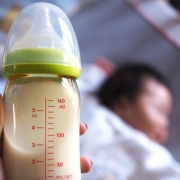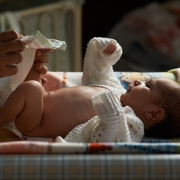
Article at a Glance

Breastmilk and properly mixed formula contain the perfect amount of water for your baby. Additional water is unnecessary and can be dangerous. As your baby advances to taking other foods, small amounts of water can be offered. Discuss this with your pediatrician at well-visits. When using water to mix formula, follow instructions on the can. … Continue reading “Water”

Breastfed infants should receive 400 IU a day of supplemental vitamin D beginning in the first few days of life and continuing for at least 4-5 months. Formula fed infants should also be supplemented with 400 IU a day of vitamin D until they are taking more than 32 ounces of formula per day. Read … Continue reading “Vitamin D”

Avoid large crowds and be careful in public places for the first 2 months of life. Good hand washing before and after handling your baby is one of the most important things you can do to prevent infection. You should always have hand sanitizer available. Anyone caring for your baby should be up to date … Continue reading “Preventing Illness in Newborns”

A pacifier may help to satisfy the need of sucking infants beyond their need to eat. The use of a pacifier at nap time and bedtime may lower the risk of SIDS (Sudden Infant Death Syndrome). Never put a pacifier on a cord around an infant’s neck, wrist or crib as this may cause accidental … Continue reading “Pacifiers”

Breastfed infants may normally have frequent, loose stools which can sometimes be confused with diarrhea. Diarrhea in children is watery and may occur 10-12 times a day. Treatment of diarrhea consists primarily of giving the baby adequate fluids while continuing the child’s regular diet. If your baby needs extra fluids, give Pedialyte, not water. Call … Continue reading “Diarrhea”

Unlike in children who are mobile and able to voluntarily put things in their mouths, true choking in newborns is rare. However, if a baby drinks very quickly he may cough and sputter a bit until he adjusts to feeding. It often proves helpful to sit him up and pat him on the back until … Continue reading “Choking”